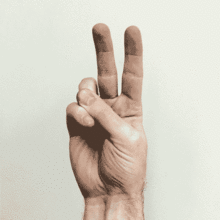Air quotes
Air quotes, also called finger quotes, are virtual quotation marks formed in the air with one's fingers when speaking. This is typically done with hands held shoulder-width apart and at the eye level of the speaker, with the index and middle fingers on each hand flexing at the beginning and end of the phrase being quoted.[1] The air-quoted phrase is—in the most common usage—very short, at most a few words. Air quotes are often used to express satire, sarcasm, irony or euphemism, among others, and are analogous to scare quotes in print.
Use of similar gestures has been recorded as early as 1927.[1] The term "air quotes" first appeared in a 1989 Spy magazine article by Paul Rudnick and Kurt Andersen, who state it became a common gesture around 1980.[2]
The gesture was used routinely in the TV show Celebrity Charades (1979) as the standard signal for a quote or phrase.

The trend became very popular in the 1990s, attributed by many to comedian Steve Martin, who often used them with exaggerated emphasis in his stand-up shows.[3] Another popularization of air quotes was the character Bennett Brauer, played on the sketch comedy show Saturday Night Live by Chris Farley, an aggressive but socially awkward commentator who used air quotes to mock societal expectations of him. Additionally, in the blockbuster Austin Powers film series, Dr. Evil makes exaggerated use of air quotes when explaining matters to his henchmen, particularly while using real phrases he erroneously believes himself to have coined such as "laser" and "Death Star".
References
| Wikimedia Commons has media related to Air quotes. |
- 1 2 Martin, Gary. "Air quotes". The Phrase Finder. Archived from the original on 3 November 2008. Retrieved 18 November 2008.
- ↑ Rudnick, Paul (March 1989). "The Irony Epidemic". Spy Magazine. p. 93-98.
- ↑ Frum, David (2000). How We Got Here: The '70s, the decade that brought you modern life, for better or worse. New York: BasicBooks. p. 421. ISBN 0-465-04196-5. OCLC 45706071.